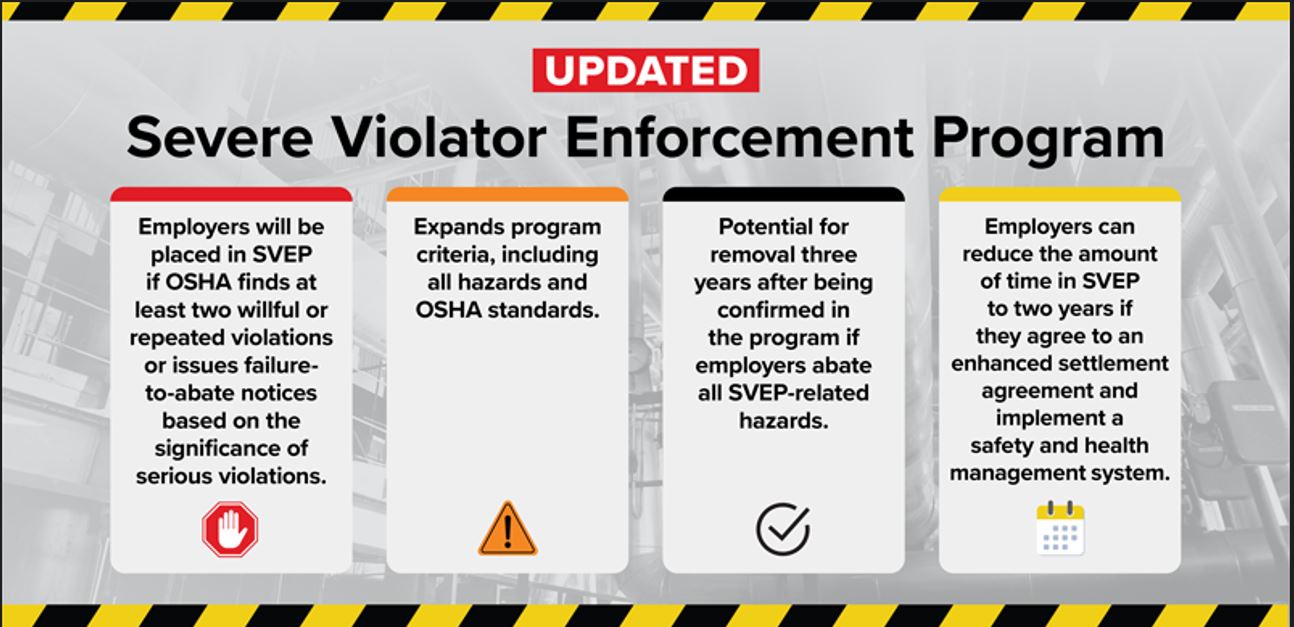OSHA is taking aim at employers who repeatedly put their workers in harm’s way on the jobsite. On September 15, the U.S. Department of Labor announced it is expanding the criteria for placement in OSHA’s Severe Violator Enforcement Program. The move targets repeat offenders: those “who continue to expose workers to very serious dangers, even after being cited for them,” explained Doug Parker, OSHA’s assistant secretary of labor, in a post on the OSHA blog.
Just how severe are these workplace hazards? Parker gave an example.
“In October 2021, an employee of a Texas metal fabrication company was using a heat torch when oxygen leaked from a hose in poor condition, causing a fire flash in the El Paso facility. He suffered second-degree burns to his left hand,” he wrote. “In January 2022, another employee suffered an amputation injury because dangerous machinery lacked proper guards. Later the same month, we received a complaint alleging employees were forced to jump approximately three feet from a ladder onto a platform with no safety rails, exposing them to a potentially deadly fall.”
Under OSHA’s previous standards, first introduced in 2010, it took 10 incidents over five years — including five repeat machine guarding violations — for that company to meet the criteria for the Severe Violator Enforcement Program (SVEP), which focuses on inspecting employers who continue to expose workers to very serious dangers, even after being cited for them. The new criteria will broaden the program’s scope to go after employers like this one.
“These changes to SVEP will hold a microscope to those employers who continue to expose workers to very serious dangers and help ensure America’s workers come home safe at the end of every shift,” Parker said.

Click to enlarge
REPEAT OFFENDERS: With its criteria update, OSHA is aiming to crack down on employers that repeatedly violate workplace safety laws. (Courtesy of U.S. Department of Labor Blog)
Specifically, the new criteria will:
- Include all hazards and OSHA standards in program criteria. Formerly, criteria was limited to cases involving fatalities, 3+ hospitalizations, high-emphasis hazards, the potential release of a highly hazardous chemical (process safety management), and enforcement actions classified as egregious.
- Place employers in the program based on violations, versus on violations that result in employee harm. “Under the old criteria, the focus was on cases where a willful or repeated serious violation, or there was a hazard the employer failed to abate, that was directly related to either an employee death or an incident that caused 3+ hospitalizations,” Parker wrote. Now the criteria is whether OSHA finds 2+ “willful or repeated violations or issues failure-to-abate notices based on the presence of high gravity serious violations,” he explained.
- Create a time frame for OSHA follow-up or referral inspections. Previously, there was no required time frame. The new requirement is within one year, but not longer than two years, after the final order.
- Move the potential for removal from the program to three years after SVEP-related hazards are abated, instead of three years from when the final order is issued. “A final order and meeting other conditions are still required for removal from SVEP,” Parker explained, “but the clock for potential removal starts when the employer fixes the hazard instead of at the end of a highly variable administrative process.”
- Allow a shorter time in SVEP (two years versus three) if the employer agrees to a safety and health management system. The system would be part of an enhanced settlement agreement and must include the seven basic elements outlined in OSHA’s Recommended Practices for Safety and Health Programs. “Previously, employers were only eligible for removal from SVEP after 3 years,” Parker wrote. “These last two changes incentivize employers to fix problems quickly and develop lasting solutions to change their health and safety culture.”






Report Abusive Comment